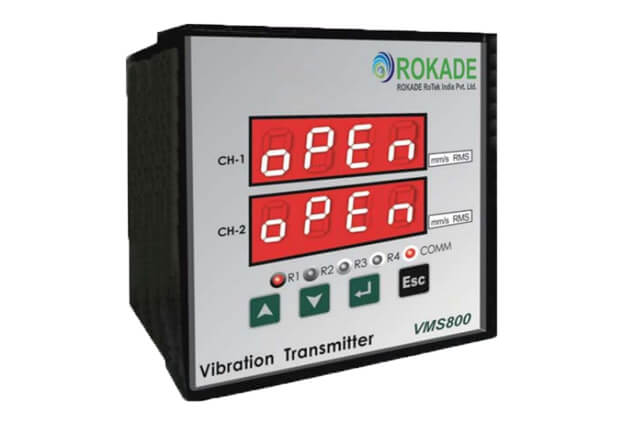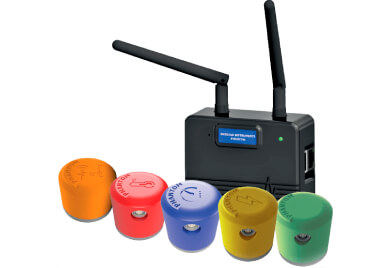Predictive Maintenance using Wireless Vibration Monitoring System (IIoT Industry 4.0)
Industry study states that 82% of companies have experienced unplanned downtime during the last three years. Unplanned downtime is something Industries are striving to steer clear of, considering the tremendous production loss and the resultant business loss.
The study also states that 64% of unplanned downtime is related to equipment failures, arising out of improper maintenance, overrunning machines and a lack of efficient machines’ condition tracking.
Now, by using Condition Monitoring Instruments manufactured with modern technologies, any Machines can be attended in real time to predict malfunctions and schedule service maintenance ahead of an actual failure.
Methods
Vibration Monitoring Kit is equipped with Sensors, which collect the data on a wide range of variables that determine its health and performance, for instance, temperature, vibration, speed, current. Once collected, the data is passed over to the cloud. The cloud software aggregates the data from sensors and applies analytics tools to develop time-series sensor data into informative insights about equipment’s health and operational parameters. A condition monitoring solution visualizes the findings and communicates them to the users in a comprehensive form, say, as charts or diagrams. In case the situation deviates from the norm, a condition monitoring solution can also send an alert to a maintenance manager, notifying them about deterioration of equipment’s condition.
The data taken by a condition monitoring solution provides valuable insights about the current state of equipment and can be applied to indirectly monitor the quality of goods in production – through monitoring the state of equipment’s components.
Aim of condition monitoring is not limited to quality control. Its findings can also be used to forecast future equipment performance, anticipate which equipment components are likely to fail – and decide on the scope of maintenance activities based on the predicted level of degradation.
Applications
Condition monitoring can be applied to a wide range of industries
1. Discrete Manufacturing
Such as Automotive Industry, whereinof welding machines, spindles in milling machines
2. Process Manufacturing
In the steel industry, condition monitoring can be used to monitor the state of cold rolling mills, particularly critical for the quality of steel and where it is difficult to inspect with portable instruments. Early recognition of rolling mills’ defects allows manufacturers to taketimely corrective action and minimize the negative impact to the output product.In pulp and paper industry, condition monitoring is applied to track the condition and the alignment of rolls and roll balance. For that, sensors collect the data on vibration and temperature and transmit it to the cloud for analysis.
3. Oil & Gas
For monitoring condition of drilling equipment, pressure vessels, storage tanks, pipelines, etc network of sensors is deployed to collect the data about drilling rigs condition. Once the data is processed, the condition monitoring solution is able to identify the equipment in the potentially critical state. Additionally, drilling rigs deploy high sensitivity IR cameras to monitor pipeline leakages by detecting differences in temperatures.
4. Electric power
Condition monitoring enablesPower Plants to ensure reliable power generation. In the electric power industry, it is used to track the health of coal-fed steam turbines, wind turbines, gas turbines, electrical substations and even nuclear power plants. With vibration and pulse shock sensors, it is possible to monitor the condition ofTurbine rotating parts, cages and gearbox bearings.
Advantages
Compiling and analysing the data about the health and performance of machinery and making the insights available in real time on the desktops or in mobile apps of reliability technicians.

Cloud storage for large amounts of data
Storing data on-premises, a manufacturer requires a data center with several dedicated servers to collect and process sensor data. As a result, the amount of data that can be stored is limited to the local data center’s storage capabilities. Moreover, in many cases the distributed nature of manufacturing facilities (as in oil & gas industry, for instance) does not allow putting a date center close to the equipment to be monitored. IoT, on the other hand, leverages cloud computing, which allows storing huge amounts of data in the cloud. It is particularly important considering the volume of data generated by connected machines. Just one wind turbine, for instance, takes 2,000 readings per minute, which makes about 1 terabyte of data a week. Leveraging Industrial IoT, manufacturers can store vast volumes of data and scale storage capacity.
Enough computing power for sophisticated analytics
A cloud-based condition monitoring solution provides enough computational resources to run machine learning algorithms.
Ability to use data from many machines
Machine learning algorithms require a significant amount of data. For instance, to train a predictive model that identifies vibration values leading to cracking of welding machines’ spindles, the data about a hundred cracking cases is needed. With the data from one machine, gathering the required amount of data would take years. On the other hand, gathering the data from several welding machines simultaneously, a data analyst can collect the required amount in about a year. Moreover, the diversity of data fetched from several physical locations increases the accuracy and improves the functionality of predictive models.
About Rokade Monitoring System
We recommend our PHANTOM – Wireless Health Monitoring System for Predictive maintenance, which is suitable for across various Industrial sectors and applications.
Our Sensor types include parameters such as Vibration, Temperature, Current, Speed and any general application having 4-20 mA output OR 0-5 volts output.
The system is capable to Monitor, analyse and help you to plan a proper maintenance schedule, thus avoiding downtime.





